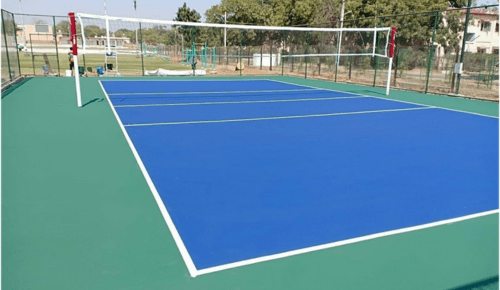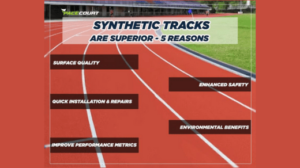Step-by-Step Guide to Designing a Volleyball Court Flooring
Designing a volleyball court is a detailed process that requires careful consideration of various factors to ensure both functionality and safety. Whether it’s for an indoor or outdoor court, the flooring plays a pivotal role in ensuring the game is played at its best. The right flooring can enhance the performance, comfort, and longevity of the court, as well as reduce the risk of injury. This step-by-step guide will help you navigate the essential stages of designing and installing the perfect volleyball court flooring.
Step 1: Understand the Court’s Purpose and Type
The first step in designing volleyball court flooring is to determine the purpose of the court—whether it’s for professional, recreational, or school use. This will influence several decisions, including the type of flooring and materials used. Volleyball courts come in two main varieties:
- Indoor Courts: These courts need flooring that provides a balanced combination of comfort, grip, and shock absorption. Indoor flooring is usually made from hardwood, sports vinyl, or synthetic materials like rubber.
- Outdoor Courts: Outdoor courts are exposed to the elements, so durability and weather resistance are crucial. Outdoor flooring is typically made from concrete, interlocking tiles, or outdoor-grade synthetic materials designed to withstand UV rays, rain, and temperature fluctuations.
Understanding the specific environment of the court—indoor or outdoor—helps you choose the right material that can support the demands of the game.
Step 2: Choose the Right Material
The material chosen for the court floor plays a major role in the overall sports court design and performance of the game. For volleyball, the floor should have the right level of traction, shock absorption, and durability. The most commonly used materials for volleyball court flooring include:
- Wooden Flooring: Ideal for indoor courts, wooden floors, particularly maple, are the traditional choice for volleyball courts. They offer excellent shock absorption and a good balance of grip. Wooden floors are also visually appealing and offer long-lasting durability when properly maintained.
- Sports Vinyl Flooring: This is a popular choice for indoor and multi-purpose courts. Sports vinyl provides a durable, non-slip surface with shock absorption properties, making it ideal for volleyball. It is relatively easy to maintain and clean, which is essential for busy venues.
- Rubber Flooring: Rubber is another excellent choice for indoor volleyball courts, offering high shock absorption and durability. It’s easy to maintain, and its resilience reduces impact on joints and muscles during play. It’s a suitable option for gyms and community centers.
- Interlocking Tiles: Often used for outdoor courts, these sports Interlocking tiles are made from durable synthetic materials designed to withstand exposure to the sun and rain. They offer ease of installation and are available in various designs and colors. The tiles also allow for quick repairs by replacing individual sections.
- Concrete and Asphalt: For outdoor volleyball courts, concrete or asphalt is the most durable option. These surfaces are weather-resistant and can withstand heavy use. However, concrete surfaces often require additional flooring treatment to make them suitable for volleyball, such as an acrylic layer for grip and shock absorption.
Step 3: Determine the Court Dimensions
Before designing the flooring, it’s essential to adhere to the official volleyball court dimensions, which are standardized by the Fédération Internationale de Volleyball (FIVB). The official court dimensions for volleyball are:
- Indoor Courts: The standard dimensions are 18 meters in length and 9 meters in width. The attack line is positioned 3 meters from the net, and the back line is 6 meters away from the net.
- Outdoor Courts: For beach volleyball, the court dimensions are slightly smaller, measuring 16 meters in length and 8 meters in width. However, these dimensions can be adjusted depending on available space and use.
These measurements are essential for the proper layout and design of the floor and help you avoid any space-related constraints during the installation.
Step 4: Incorporate Shock Absorption Features
Volleyball is a high-impact sport, and players are often jumping, diving, and landing on the court. This means shock absorption is a critical consideration for the court’s flooring. Without proper shock absorption, players may face a higher risk of injury, particularly to their knees, joints, and ankles.
To enhance shock absorption, choose a flooring material that combines cushioning properties with resilience. For indoor courts, wooden or rubber flooring with an underlayment pad can provide an ideal balance of comfort and support. For outdoor courts, the use of interlocking tiles or synthetic surfaces can be augmented with shock-absorbing layers for enhanced player protection.
Step 5: Consider Surface Traction and Grip
The Volleyball flooring materials must also provide the right level of grip to ensure that players can move swiftly and change direction without slipping. However, too much grip can lead to excessive friction, which could cause players to strain muscles. A balanced, textured surface with moderate grip is necessary for the optimal performance of the court.
For indoor volleyball courts, sports vinyl or hardwood flooring provides good traction, while for outdoor courts, interlocking tiles with textured surfaces or synthetic coatings can offer the desired amount of grip.
Step 6: Focus on Aesthetics and Functionality
While the functional properties of the flooring are of the utmost importance, aesthetic appeal shouldn’t be overlooked. Many sports facilities want their courts to reflect their branding or create a visually appealing environment. Flooring options come in various colors and designs, so you can choose a layout that complements the aesthetic vision for the venue.
Some courts also opt for lines and markings painted or installed on the floor, ensuring they meet the official standards for volleyball. These markings must be visible and durable, especially for outdoor courts that face wear and tear from the elements.
Step 7: Ensure Proper Installation
Proper Volleyball court installation is critical for ensuring the longevity and safety of the flooring. Whether you choose interlocking tiles, vinyl sheets, or wooden panels, make sure the flooring is installed correctly. For indoor courts, professional installation is often recommended to ensure the material is laid evenly, and seams are sealed to prevent uneven surfaces.
For outdoor courts, proper drainage is also crucial. If moisture collects underneath the flooring, it can lead to mold, rot, or premature wear. Therefore, installation should include adequate drainage planning.
Conclusion
Designing the perfect volleyball court flooring involves a combination of choosing the right material, ensuring safety features like shock absorption, and focusing on aesthetics. By carefully considering the court’s purpose, materials, dimensions, and installation, you can create a volleyball court that maximizes player performance, minimizes injury risk, and stands the test of time. Whether it’s for a community center, school, or professional facility, a well-designed volleyball court floor is essential for an enjoyable and safe playing experience.


